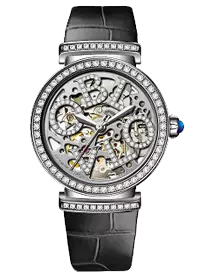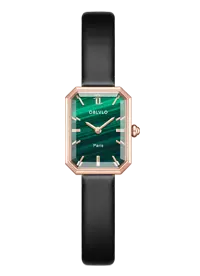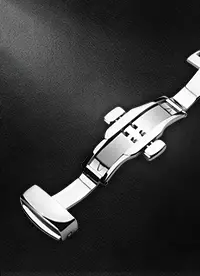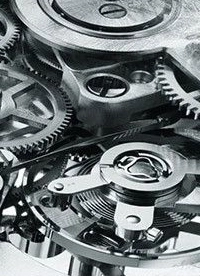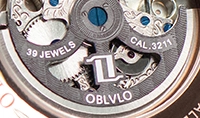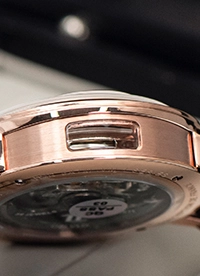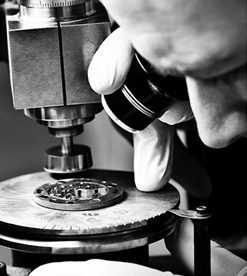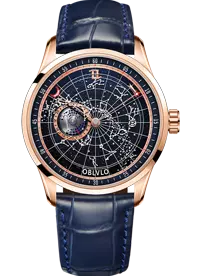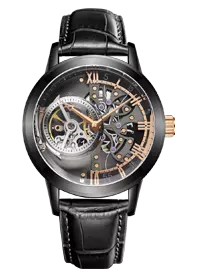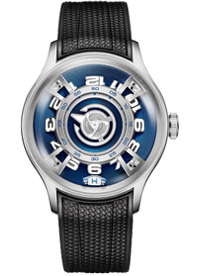L'ASTRONOMO
SKY IN MOTION
THE MOON PHASE COMPLICATION
Thanks to the invention of the telescope, Galileo Galilei made revolutionary discoveries concerning the appearance and the movement of the moon. He made remarkably beautiful drawings of what he saw with an accuracy and attention to detail which is still amazing even today. So, in a timepiece dedicated to him, nothing would be more logical than the moon phases indication, a classic complication of high-end watchmaking which has interpreted in its own way and with an accuracy of a century. On the back of the new L'Astronomo’s P.2005/GLS movement is a day/night indicator which also clearly displays the phases of the moon, by means of a system consisting of two superimposed discs which rotate in combination. The upper disc - which is read by a small external index fixed onto the movement - displays the 24 hours of the day, showing the sun during the hours of daylight and the stars of the sky at night. At the centre of the starry sky is a little round window through which the lower disc can be seen; on this appears the moon, its shape evolving day by day as a result of a small supplementary rotation of this disc of about 6.1° per day, a figure based on the exact duration of one lunar cycle (an average of 29 days, 12 hours, 44 minutes and 3 seconds).
THE POLARISED CRYSTAL DATE
As well as the moon phases indicator, the hand-wound P.2005/GLS calibre also has the characteristic Tourbillon escapement, which can be admired both from the front as well as from the back of the watch thanks the sophisticated work of Skeletonising the movement and the absence of an actual dial. All the elements which would be found in a traditional dial appear on the movement or the flange, and the three spring barrels, which store enough power to last at least four days, are visible through the open back, which also enables the power reserve indicator mounted on the movement to be read. In a watch with this construction, a date disc designed in the traditional way would to some extent conceal the fascination of the Skeletonised movement, because it would cover part of the components. The Laboratorio di Idee at the Manufacture in Neuchâtel has therefore designed an innovative system - exclusively patent pending by - in which the date disc is made of borosilicate glass and the numbers of the days have lasermodified optical properties. The numbers are virtually invisible in all positions except for the one that is aligned with the little date window, where a further polarised crystal, situated above the date disc, causes the number to appear so that it is perfectly legible.
THE EQUATION OF TIME
Over a year, the time indicated by a watch with perfect timekeeping will differ from the time indicated by a sundial when the sun is at its zenith. This difference ranges between -16 minutes 23 seconds and +14 minutes 22 seconds. This variation is called the Equation of Time and it can be calculated by trigonometric functions and empirical constants.
It is indicated on the dial of L’Astronomo by a linear cursor positioned at 6 o’clock, which moves to display the current value of the equation of time. The equation of time indicates the difference between “true solar time” - when the sun is at its highest point in the sky - and “mean solar
SUNRISE AND SUNSET
L’Astronomo has two indicators, visible at each side of the dial, which display the time of Sunrise and Sunset according to the coordinates of latitude and longitude originally specified by the client. This function is achieved by a device with two cams - produced exclusively to match the coordinates supplied by the client - fitted inside the movement. STAGES OF CREATING THE CAMS 1 . A calculation tool enables an exact graph of sunrise and sunset times at the city chosen to be drawn. This information is transferred onto two cams. The cams are created using special 3D software. The cams are fitted into the movement and their interaction with the other parts is checked.






















